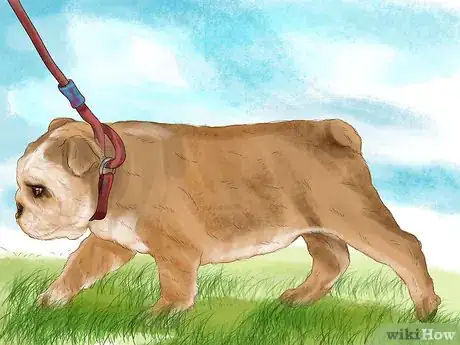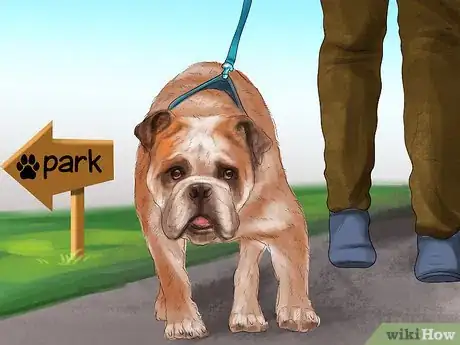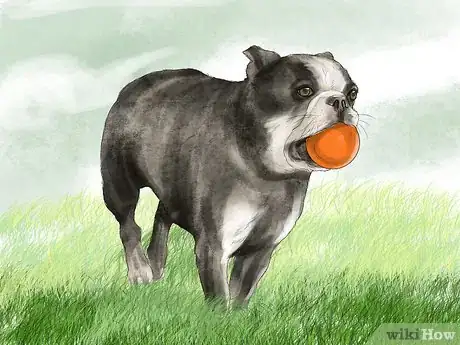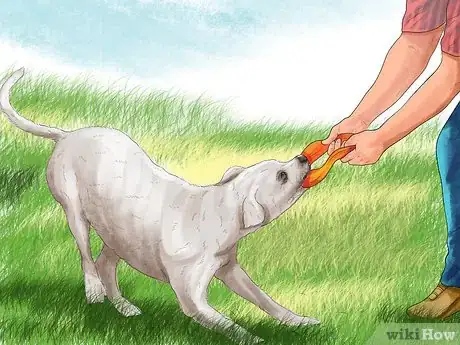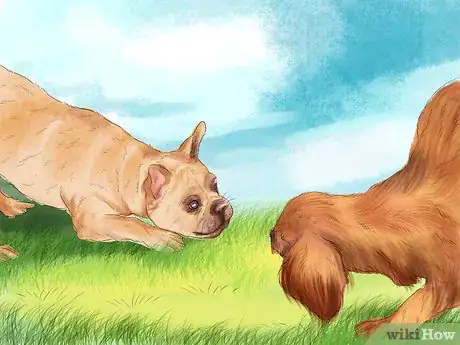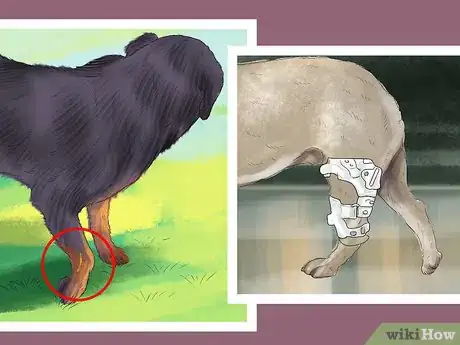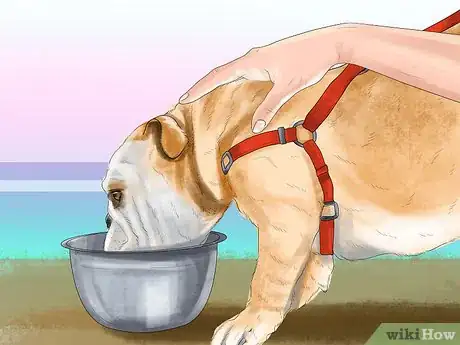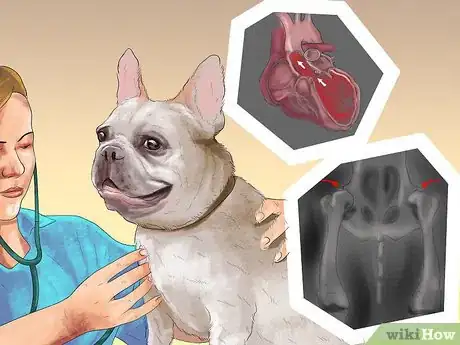This article was co-authored by Melissa Nelson, DVM, PhD. Dr. Nelson is a Veterinarian who specializes in Companion and Large Animal Medicine in Minnesota, where she has over 18 years of experience as a veterinarian in a rural clinic. She received her Doctor of Veterinary Medicine from the University of Minnesota in 1998.
This article has been viewed 56,931 times.
The English Bulldog is a breed that has numerous health problems and requires very moderate exercise. Keep your pet as happy and active as possible by scheduling a half hour a day for their physical activity, including at least one short walk a day. Play games like fetch and tug of war, and bring them to the park to allow them to be social. Make sure that your dog is ready for the elements and keep a close eye on their health and well-being while you exercise them.
Steps
Keeping Your Bulldog Active
-
1Schedule 20 – 40 minutes of exercise a day. Set aside at least 20 but no more than 40 minutes a day for exercising your adult English Bulldog. This may mean letting your dog into the backyard or bringing them to a park to move around — either way, the physical activity should be restricted to a half hour total. For the rest of the day your English Bulldog should be kept indoors and relatively inactive, which tends to be typical of the breed anyway.
-
2Go for a brief walk everyday. Despite the limits an English Bulldog owner should be placing on exercise, this breed tends to be prone to behavioural issues if not taken for a walk everyday. Walking meets the dog's primal canine need to migrate and change scenery, however briefly. To limit physical exertion but keep up the daily ritual, take your English Bulldog for a brief trip around the block at least once a day to keep them happy.[1]
- For a real change of scenery that doesn't exert your pet, try driving your dog to a park or different neighborhood to walk and explore.
Advertisement -
3Play fetch. Like other breeds of dog, English Bulldogs enjoy playing fetch — but in shorter intervals and within a smaller space. Once you have your dog's attention, throw a familiar object (i.e. a favorite toy)for them to retrieve. Make sure to toss it only a short distance away so that your dog can retrieve it without strain.[2]
-
4Play tug of war. While English Bulldogs may have a host of joint problems, they also have very strong jaws, making tug of war an ideal game to play with them. The breed is also laid back enough that there is little threat of the game getting out of hand, or of your dog getting aggressive about it. Make sure to choose a sturdy rope to play with, and be careful that your dog does not overexert themselves.[3]
- Tug of war can be played indoors or outdoors, making it perfect for any occasion.
-
5Give your dog the opportunity to be social. While English Bulldogs may not be a very active breed, they love to socialize and explore. Look for activities that allow your dog can get outside and be around people (or other pets) without exerting too much energy. For instance, bring your dog to a park and spend time sitting with them or walking at a mellow pace, people watching and enjoying nature.[4]
Keeping an Eye on Your Dog's Health
-
1Prepare your dog for the weather. English Bulldogs thrive in temperate climates and are sensitive to extreme heat or cold. In hot weather, they are likely to have trouble breathing and overheat, while in cold weather they can chill easily. Dress your dog for walks outside in cold temperatures (e.g. purchase a dog coat or sweater at a pet store or online) and make sure to bring water along for walks in the heat.[5]
- In hot weather, schedule walks for the early evening, when the weather is moderate and cool.
-
2Watch for overheating. Overheating is a common problem with English Bulldogs, who should be monitored carefully during exercise. Signs of heat exhaustion include heavy, labored breathing and panting; a swollen airway; a buildup of white foam in the throat (due to heavy breathing); vomiting; and a general look of distress. Heat exhaustion can cause death for this breed, so act fast and do the following:
- Remove your dog from the heat — bring them to a shady area or preferably inside, and turn on a fan.
- Keep your dog calm by reassuring them with a soft, soothing voice.
- Cool your dog down however possible — pour cool water on their extremities (head, paws, tail); rub ice around their head or under their tail or armpits; or place them in a cool bath (do not use cold water — you risk hypothermia if your dog gets too cold).
- Take your dog's temperature rectally. A dog's normal temperature is about 101.5°F (38.6°). If their temperature is over 105°F (40.6°C), then your dog likely has heat stroke. You want to reduce their temperature to 103°F (39.4°C) but no lower, as this may put the dog at risk for hypothermia. Once you have reduced their temperature, take the dog to the vet.[6]
- If you can't cool your dog down, bring them to a vet immediately.
-
3Look for limping. English Bulldogs are more susceptible to weak joints and injuries than other breeds due to their heavy weight and short limbs. They also have a high threshold for pain, which means that they may continue to run and play after suffering an injury, further damaging their joints or muscles. If you see your dog limping or exhibiting any other signs of injury, bring them inside to rest immediately or bring them to a vet if the injury seems severe.
-
4Stop activity at the first signs of exhaustion. If your English Bulldog starts to look distressed or exhausted while exercising, stop immediately and have them rest. The breed is known for having irregular energy levels so sudden fatigue is not uncommon. Be sure to give your dog plenty of water and keep them calm during a bout of tiredness.[7]
-
5Keep up regular vet visits. As a breed, English Bulldogs have a comprised anatomy and are more susceptible to a long list of health ailments (including dermatitis, hip and elbow dysplasia, heart disease, and degenerative spine disease) than other breeds. Schedule regular appointments with your veterinarian and ask for specific advice on diet and exercise to keep your dog at a healthy weight. Your vet can also help you monitor your pet's joint and muscle health, and diagnose conditions like arthritis.[8]
References
- ↑ http://www.dogbreedinfo.com/bulldog.htm
- ↑ http://www.bulldogsworld.com/general/exercising-your-bulldog-every-season
- ↑ https://www.cuteness.com/article/english-bulldog-games
- ↑ http://www.betterbully.com/english-bulldog-health-problems/
- ↑ http://www.hillspet.com/en/us/dog-breeds/english-bulldog
- ↑ http://www.akcchf.org/canine-health/your-dogs-health/caring-for-your-dog/heat-stroke-and-heat-exhaustion.html
- ↑ http://www.betterbully.com/english-bulldog-health-problems/
- ↑ http://www.betterbully.com/english-bulldog-health-problems/
About This Article
To exercise an English bulldog, set aside 20 to 40 minutes every day for exercising. Short-distance fetch and playing tug-of-war are great ways to exercise a bulldog, or you can simply let it out into your backyard to run around and explore. You can also take your dog on a brief walk around the block once per day, but because of physical problems related to this breed, keep it indoors and relatively inactive for the rest of the day to prevent injury. For tips on protecting your bulldog from outdoor temperatures, read on!
